 |
Dr. William Strauss heads up FutureMetrics.com, a group of economists and business experts who provide economics, statistics, finance, and accounting analysis and forecasting to businesses and government. Dr. Strauss sent me the firm’s August 2009 Pension Status Report yesterday. I found it so startling that I thought I’d better pass on the highlights to you right away, along with a summary of the email discussion that he and I had on it.
Corporate pension funding shortfalls are a major operating cash flow problem for the corporations that experience shortfalls because by law corporations must finance pension funds to 100% over time. Pension fund shortfalls were problematic for most companies even before the financial crisis. Post crisis, the number of pension funds that are not 100% or better funded has increased from 67.6% in FY 2008 to 92.7% in FY 2009 ending in June. The median funded level is a mere 46%.
The pension funding shortfalls crisis initially appeared between 2002 to 2003 from a combination of falling stock prices and interest rates. The combination turned thousands of previously fully funded pension plans into underfunded plans.
Why? A pension plan’s liabilities are for payments that are made decades in the future. To evaluate the adequacy of a plan’s funding, discount obligations to a present value.
Background: Present value is calculated on the assumption that a dollar received today, as income or other payment, is worth more than a dollar that is received in the future. A dollar received today can be put to work immediately whereas a dollar received in the future cannot be put to work earning money until a future date. If the dollar earns four percent today and in the future, $1 today will return $1.04 in one year, so $0.96 today is $1 in the future. In a low interest rate environment, this fact is critical: the higher the rate of interest, the lower the present value today. Conversely, the lower the rate of interest, the higher the present value today.
Now consider the pension fund obligation versus the asset value side of the funding equation, the money that the pension fund earns versus the money the pension funds owes. The value of a dollar owed decades from tomorrow is a smaller obligation than a dollar owed tomorrow. But expand the time frame out to decades and the level of obligation compounds with each passing year. When interest rates are low, as they are today, pension funding calculations do not discount a pension’s future obligations nearly as much as when interest rates are high. As a result, the net present value of the obligations increases in a low interest rate environment.
An adequate funding level requires that either asset values rise from increased contributions and rising stock prices, or liabilities decline via rising interest rates or greater participant attrition. An environment of low interest rates and low stock prices is a double whammy for pension funding because the net present value of liabilities increases as the net present value of assets falls.
As bad as the 2002 to 2003 period was for pension funds, the current crisis is nearly three times worse from a returns perspective, with no letup in sight.
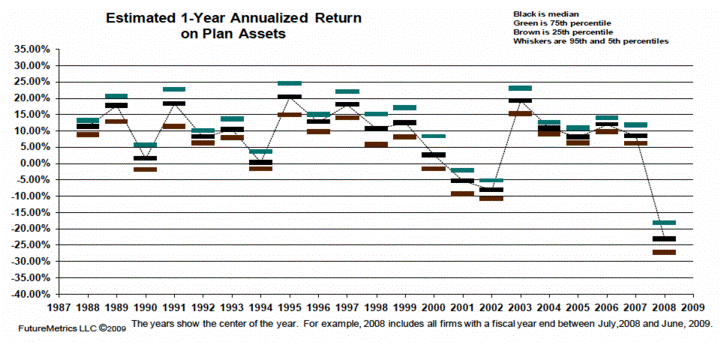
Falling stock prices and low interest rates hammers return on corporate pension fund assets.
Estimated annualized are -23% for the median pension fund versus -8% at the bottom of the previous crisis.
Pension Fund Exposure
What's the total under funded pension plan exposure for U.S. corporations? What percentage of pension funds are underfunded and how much money does the aggregate level of underfunding represent?
Corporate pension funds appear to have been in decent shape before the financial crisis. FutureMetrics’ analysis shows that even before the crisis the majority of pension funds were in trouble.
The first chart below shows the distribution of funded levels for the 2007 and 2008 cohorts for July 2008 to June 2009 fiscal year ends. The chart also shows the best-fit probability distribution.
What's the total under funded pension plan exposure for U.S. corporations? What percentage of pension funds are underfunded and how much money does the aggregate level of underfunding represent?
Corporate pension funds appear to have been in decent shape before the financial crisis. FutureMetrics’ analysis shows that even before the crisis the majority of pension funds were in trouble.
The first chart below shows the distribution of funded levels for the 2007 and 2008 cohorts for July 2008 to June 2009 fiscal year ends. The chart also shows the best-fit probability distribution.
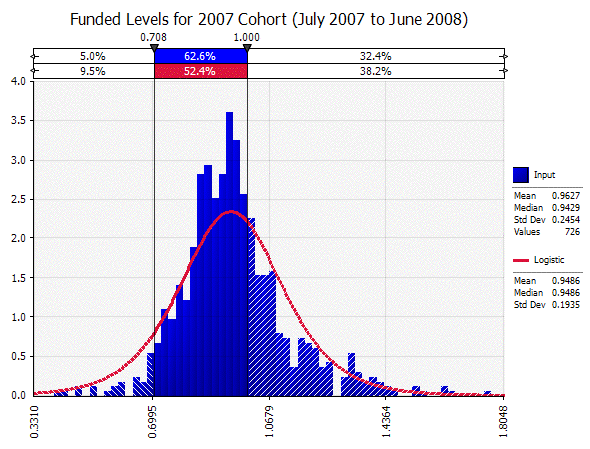
FY 2008
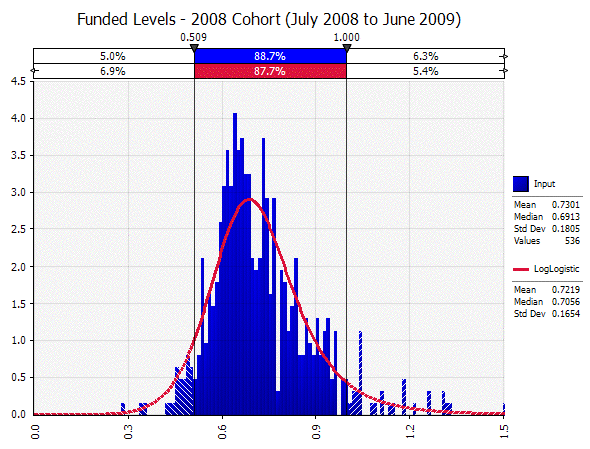
FY 2009
Dr. Strauss says, "We recalculate the funds’ liabilities using our proprietary algorithm which uses a benchmark discount rate based on U.S. long treasuries and the median of firms’ salary inflation rates. You will note in the chart that compares the discount rate assumptions with long treasuries (page 9) that firms are discounting very aggressively. The reported median funded level is 69% (page 4). After our “adjustment” we calculate the median funded level at 46%!
From a total dollar liability standpoint, only 32.4% of the funds were 100% or better funded in 2007. That fell to 6.3% in 2008. That means that 92.7% of corporate pension funds are under-funded.
The shortfalls must, by law, be paid by corporations, so 92.7% of U.S. corporations with pension fund obligations will have to divert cash into pension funds and away from operations or investing in growth. That has implications for the financial health and long run viability for U.S. corporations, particularly those that are already in trouble financing debt and other obligations.
I asked Dr Strauss if he'd run the numbers for us to estimate the total shortfall in dollars so we can estimate the total liability to corporations' cash flows. His reply starts off: “These are big numbers.”
One, markets recover to 2007 levels to bring pension fund asset levels back up to even FY 2008 levels when 32.4% of the funds were 100% or better funded versus 6.3% in 2009. That will allow more companies to meet their pension fund obligations. We believe that this scenario is unlikely as the debt financed FIRE Economy continues to deteriorate over the next ten years. Even if that does happen, that still leaves 67.6% of plans under funded. That’s the best case.
Two, markets will not recover and pension fund promises will not be kept. More firms will go bankrupt and allow the Pension Benefit Guaranty Corporation (PBGC) to compensate pensioners. But the level of payouts that the PBGC makes are typically much lower than the original pension promises. Recent airline bankruptcies are indicative. At the time the PBGC took over Delta Airline’s pension plan, for example, it had $1.7 billion in assets and more than $4.7 billion in liabilities. The PBGC's estimated that it is liable for only one third of the $3 billion shortfall. Back of the envelope, pilots who worked for Delta for decades will receive about half the money they expected to receive, that is, their own money.
Firms that do not go bankrupt have to finance shortfalls out of operating cash flow. Two obvious questions arise. One, how can firms rehire if they are diverting funds to finance pension fund obligations? And two, how much of a liability does this represent?
If 92.7% of U.S. corporations have pension funds that are less than 100% or better funded, and the total aggregate shortfall is $325 billion, and total quarterly after tax profits of all corporations in Q1 2009 (according to the U.S. Department of Commerce: Bureau of Economic Analysis) is $1.05 trillion ($4.2 trillion annualized), and Q1 2009 Corporate Net Cash Flow (BEA) is $1.5 trillion ($6 trillion annualized), then the total aggregate unfunded pension fund liability represents 8% of profits and 5% of cash flows annually.
Medical Pensions: 81% underfunded
Pension plan underfunding is a serious problem, but medical pensions funding is worse.
Strauss explains why: “Corporations can walk away from medical pension promises without any real legal impact. That is why they are so unfunded. But as you rightly point out, that will shift more of the burden to the government programs.”
From a total dollar liability standpoint, only 32.4% of the funds were 100% or better funded in 2007. That fell to 6.3% in 2008. That means that 92.7% of corporate pension funds are under-funded.
The shortfalls must, by law, be paid by corporations, so 92.7% of U.S. corporations with pension fund obligations will have to divert cash into pension funds and away from operations or investing in growth. That has implications for the financial health and long run viability for U.S. corporations, particularly those that are already in trouble financing debt and other obligations.
I asked Dr Strauss if he'd run the numbers for us to estimate the total shortfall in dollars so we can estimate the total liability to corporations' cash flows. His reply starts off: “These are big numbers.”
Aggregate total pension liability for all U.S. corporate pension funds, based on data from plans representing 92% of U.S. corporate pension assets, is $1.48 trillion while aggregate total assets is $1.15 trillion, leaving a shortfall of $325 billion.
There are two possible outcomes for unfunded pension liabilities.One, markets recover to 2007 levels to bring pension fund asset levels back up to even FY 2008 levels when 32.4% of the funds were 100% or better funded versus 6.3% in 2009. That will allow more companies to meet their pension fund obligations. We believe that this scenario is unlikely as the debt financed FIRE Economy continues to deteriorate over the next ten years. Even if that does happen, that still leaves 67.6% of plans under funded. That’s the best case.
Two, markets will not recover and pension fund promises will not be kept. More firms will go bankrupt and allow the Pension Benefit Guaranty Corporation (PBGC) to compensate pensioners. But the level of payouts that the PBGC makes are typically much lower than the original pension promises. Recent airline bankruptcies are indicative. At the time the PBGC took over Delta Airline’s pension plan, for example, it had $1.7 billion in assets and more than $4.7 billion in liabilities. The PBGC's estimated that it is liable for only one third of the $3 billion shortfall. Back of the envelope, pilots who worked for Delta for decades will receive about half the money they expected to receive, that is, their own money.
Firms that do not go bankrupt have to finance shortfalls out of operating cash flow. Two obvious questions arise. One, how can firms rehire if they are diverting funds to finance pension fund obligations? And two, how much of a liability does this represent?
If 92.7% of U.S. corporations have pension funds that are less than 100% or better funded, and the total aggregate shortfall is $325 billion, and total quarterly after tax profits of all corporations in Q1 2009 (according to the U.S. Department of Commerce: Bureau of Economic Analysis) is $1.05 trillion ($4.2 trillion annualized), and Q1 2009 Corporate Net Cash Flow (BEA) is $1.5 trillion ($6 trillion annualized), then the total aggregate unfunded pension fund liability represents 8% of profits and 5% of cash flows annually.
Medical Pensions: 81% underfunded
Pension plan underfunding is a serious problem, but medical pensions funding is worse.
Strauss explains why: “Corporations can walk away from medical pension promises without any real legal impact. That is why they are so unfunded. But as you rightly point out, that will shift more of the burden to the government programs.”
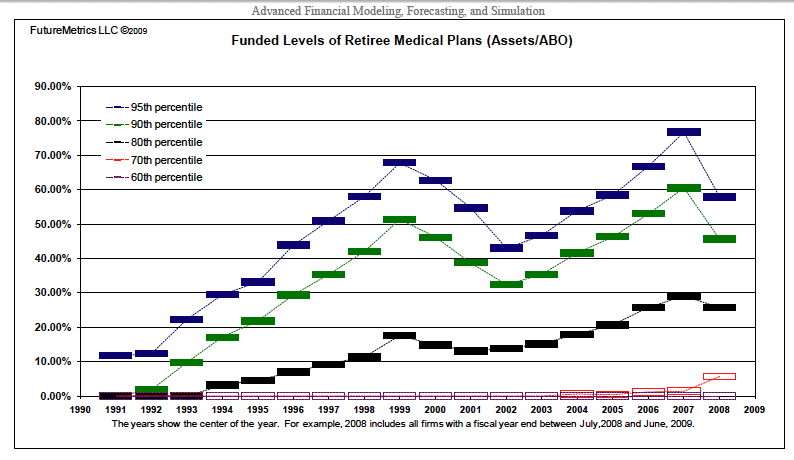
Even the 95th percentile medical pension funds are less than 60% funded
The aggregate total medical retiree benefit obligation based on 92% of U.S. corporate pension assets is $318 billion, but aggregate total assets is only $62 billion. The shortfall is $256 billion, or 81% of liabilities.
Only 35% of medical pension plans have any funding. The other 65% have no assets at all. Of those that are funded, 39.7% are than 25% funded, and only two firms are funded greater than 100%.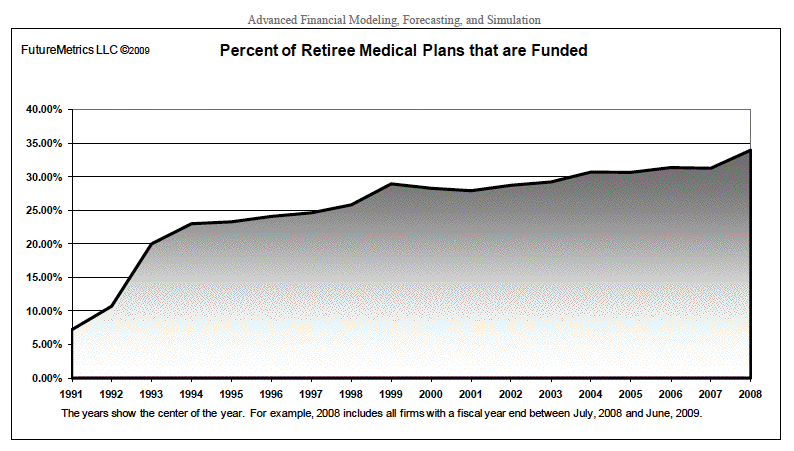
Only 35% of medical pension plans have any funding. The other 65% have no assets at all.
In the coming years, corporate pension fund shortfalls will consume operating cash flows. This will reduce hiring and slow recovery. In the long run, as taxpayers, we will likely pick up that tab for underfunded medical pensions in the coming years. Then again, compared to the $9 trillion in deficits that the CBO recently estimated for the next ten years, this latest represents another two or three shovels full of public debt heaped on top of a mountain of it that started life as a private sector commitment.
Click on the link August 2009 Pension Status Report to read the full report.
iTulip Select: The Investment Thesis for the Next Cycle™
__________________________________________________
To receive the iTulip Newsletter or iTulip Alerts, Join our FREE Email Mailing List
Copyright © iTulip, Inc. 1998 - 2009 All Rights Reserved
All information provided "as is" for informational purposes only, not intended for trading purposes or advice. Nothing appearing on this website should be considered a recommendation to buy or to sell any security or related financial instrument. iTulip, Inc. is not liable for any informational errors, incompleteness, or delays, or for any actions taken in reliance on information contained herein. Full Disclaimer
Click on the link August 2009 Pension Status Report to read the full report.
iTulip Select: The Investment Thesis for the Next Cycle™
__________________________________________________
To receive the iTulip Newsletter or iTulip Alerts, Join our FREE Email Mailing List
Copyright © iTulip, Inc. 1998 - 2009 All Rights Reserved
All information provided "as is" for informational purposes only, not intended for trading purposes or advice. Nothing appearing on this website should be considered a recommendation to buy or to sell any security or related financial instrument. iTulip, Inc. is not liable for any informational errors, incompleteness, or delays, or for any actions taken in reliance on information contained herein. Full Disclaimer

 .
.

Comment